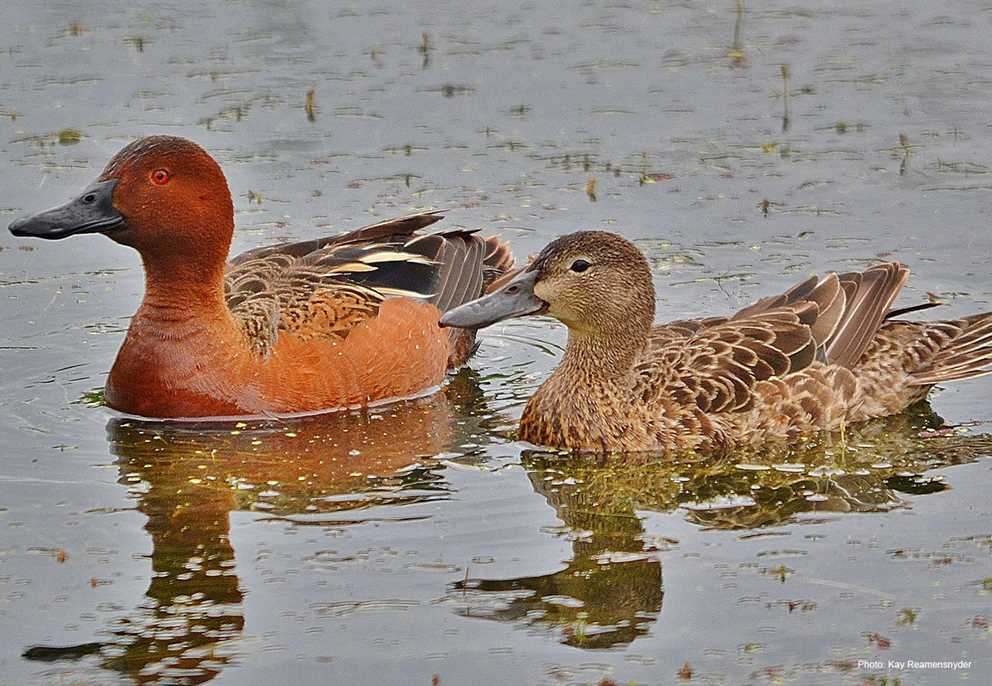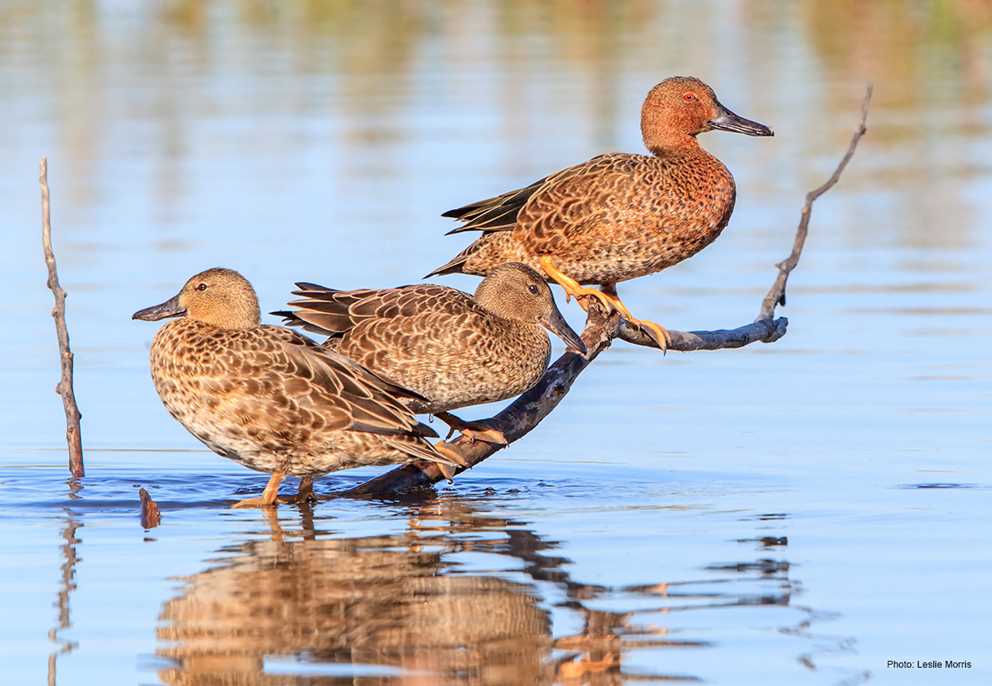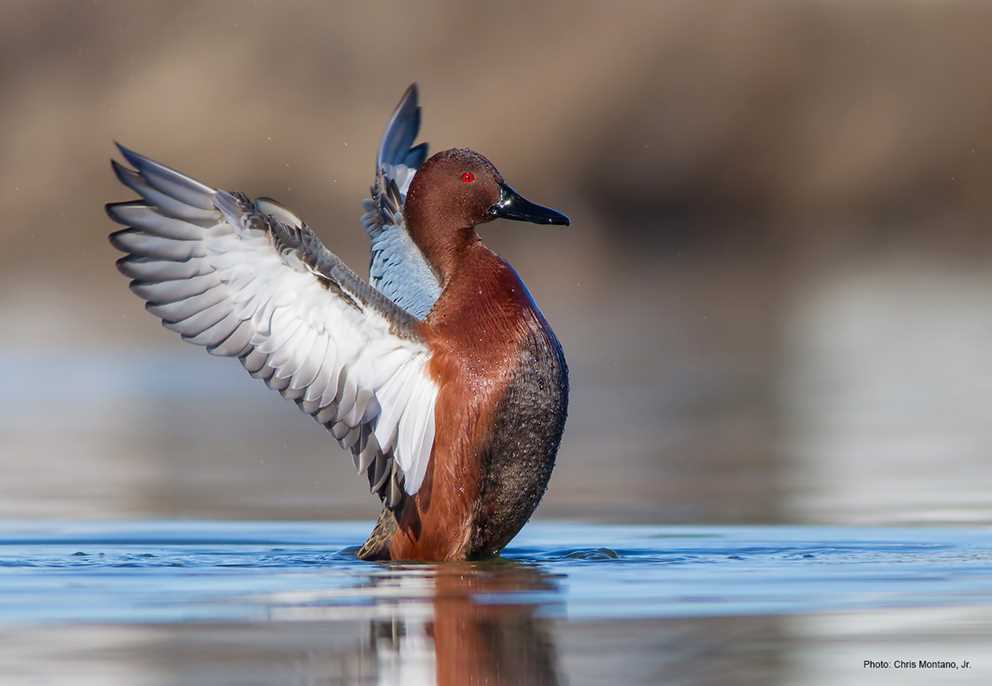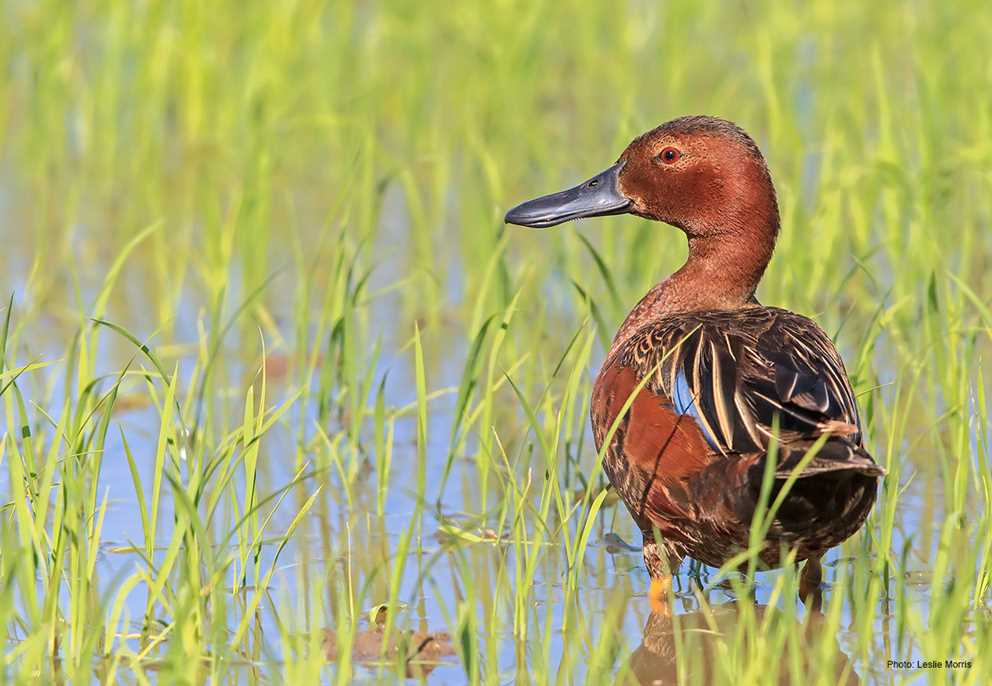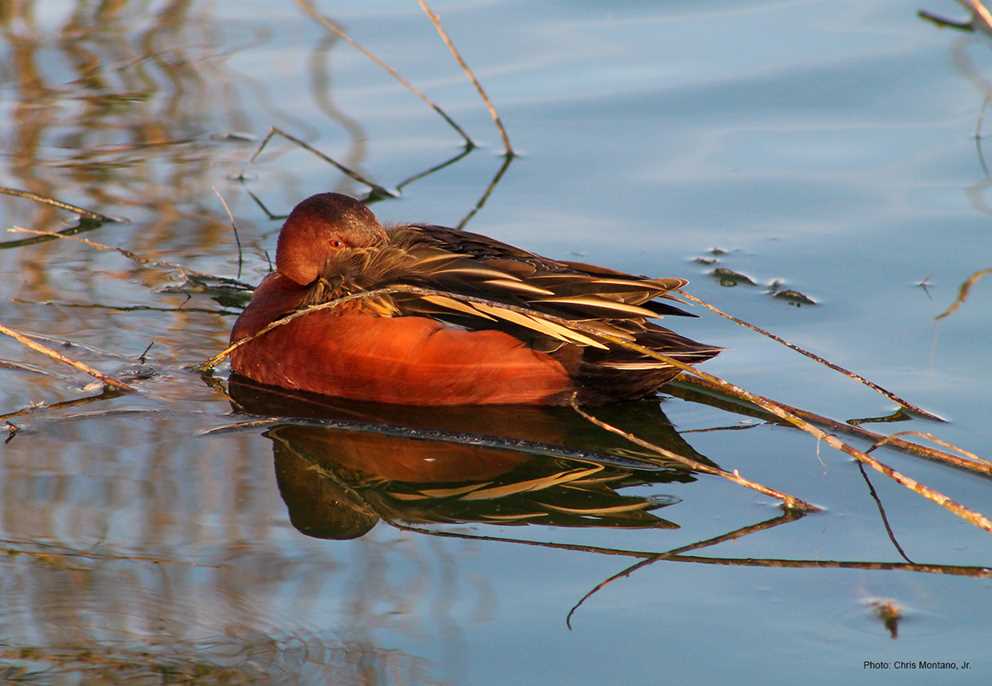Overview
The Cinnamon Teal is a small dabbling duck with breeding populations in both North and South America. The breeding range in North America includes the Great Basin and Intermountain West regions from southern British Columbia and southern Alberta, and east from Montana to western Texas and south to the Central Highlands of Mexico. The majority of birds breeding in North America winter in Mexico, with smaller numbers wintering in California, Arizona, New Mexico, and southwestern Texas. In South America, there is small breeding population in Columbia, and then a larger resident breeding population in coastal Peru, Bolivia, Argentina, and Chile. Cinnamon Teal predominantly use freshwater wetlands throughout their range, though in coastal areas of the United States and Mexico they also use brackish wetlands.
Cinnamon Teal are named for the bright cinnamon-red plumage of the adult male in alternate plumage. Both sexes have a powder blue wing patch on their upper wing, but it is much brighter and has an anterior white border on the secondary coverts in males. The back, rump, upper tail coverts and tail are mottled brown. The bill is black, somewhat spatulate, and the legs and feet are yellow orange.
Description
Key Identification Features
- Both sexes show a powder blue wing patch in flight. The speculum is green but much darker and duller in females, and the anterior white border is present on males, but the border in females has much more brown. Males have a scarlet red iris that is absent in females (and absent in Blue-winged Teal).
Male/Female Average Length and Weight
- Mass: Very little information available. Male ~0.8 lbs.; Female ~0.7–0.9 lbs.
- Wing Length: Male ~7.5 in.; Female ~7.2 in.
Male Identification
- Alternate (Breeding) Plumage: Males in alternate plumage are unmistakable and have a cinnamon-red head, neck, and underparts. The back, rump, upper tail coverts and tail are brown. The bill is black, somewhat spatulate, the iris is scarlet red, and the legs and feet are yellow orange. The blue patch on the wing is brighter than in females, and the speculum is iridescent green with bold white secondary coverts forming the anterior border. Hunters often encounter males in the early portions of hunting seasons that still have basic plumage aspects that make them appear Indistinguishable from females and to Blue-winged Teal. The intensity of the blue wing patch and green speculum and absence of brown in the secondary coverts is useful to separate males from females and the scarlet iris separates adult males from females and Blue-winged Teal.
- Basic Plumage: Overall mottled brown, sexes somewhat similar, adult males will have a scarlet red iris that separates them from females.
Female Identification
- Alternate (Breeding) Plumage: Females are nearly identical to female Blue-winged Teal and cannot reliably be separated in the field. The bill is gray black, somewhat spatulate, and the legs and feet are pale yellow orange. The wing of the female has a somewhat duller blue patch, the anterior border of the speculum has brown edging in the white secondary coverts and the speculum has less green iridescence compared to males.
- Basic Plumage: Overall mottled brown, sexes somewhat similar, adult males will have a scarlet red iris that separates them from females.
In-flight Identification
- In flight, the powder blue wing patch is distinctive, but also present on Blue-winged Teal and Northern Shovelers.
Vocalizations
- Poorly known. Females make a “gack-gack-ga-ga” similar to the Northern Shoveler.
Similar Species
- In flight, the powder blue wing patch is distinctive, but also present on Blue-winged Teal and Northern Shovelers. Males in alternate plumage are easily distinguished by cinnamon red plumage. In basic plumage, separation is not possible from Blue-winged Teal except adult males will have a scarlet red iris not present in Blue-winged Teal. Separation from Northern Shovelers in basic plumage is based on bill shape, wing length, and overall size. Immature male and all female Northern Shovelers typically show orange in the bill that is not present in Cinnamon or Blue-winged Teal.
Habitat Preferences
- Cinnamon Teal diet varies across seasons and habitats. Breeding birds favor a variety of invertebrates and feed heavily on aquatic insects, crustaceans, and clams, but also ingest seeds of aquatic and emergent plants. In fall and winter, the diet is variable and opportunistic and includes a variety of seeds and invertebrates.
Foraging Habits and Diet
- Cinnamon Teal diet varies across seasons and habitats. Breeding birds favor a variety of invertebrates and feed heavily on aquatic insects, crustaceans, and clams, but also ingest seeds of aquatic and emergent plants. In fall and winter, the diet is variable and opportunistic and includes a variety of seeds and invertebrates.
Breeding Habits
- Monogamy: Cinnamon Teal are seasonally monogamous. Timing of pairing is not known, but probably late winter and early spring. Nesting dates vary with both elevation and latitude but are usually March to May.
- Clutch Size: Averages 8 to10 eggs. The eggs are off-white to pale buff, sub-elliptical, and are ~1.8 by1.3 in. The incubation period is around 21–25 days.
Migration & Distribution
- Cinnamon Teal in North America are late summer to early fall migrants, often departing breeding areas in August or early September. They arrive in wintering areas as early as early September, and most are in wintering areas in Mexico by November. They are mid-spring migrants departing winter areas in the latter half of March or in April with arrival on breeding areas depending on altitude and latitude from March to May.

Conservation Status
- IUCN Status: Least Concern
- Population Status: The North American breeding population is estimated to be ~260,000–300,000, with a fall population estimated at 500,000–600,000, which would make it among the least abundant dabbling ducks in North America. The breeding range is a vast area with relatively low wetland density, and is largely outside of the USFWS WPBHS area, so estimates should be used cautiously. Breeding Bird Survey data suggest a declining trend for the species.
- Conservation Concerns: Water scarcity in the West has reduced wetland habitats for Cinnamon Teal and agricultural grazing has degraded upland vegetation used for breeding habitat.
- Conservation Focus: Wetland protection, enhancement, and restoration has been undertaken in western states targeting habitat for Cinnamon Teal as well as management projects including livestock fencing.
Harvest Information
- An average of 33,913 Cinnamon Teal were harvested per season across the US during the 2019 through 2022 hunting seasons. · Cinnamon Teal harvest only occurs in the Pacific Flyway with the top three states for Cinnamon Teal harvest, based on annual averages across the 2019–2022 hunting seasons were California (22,553), Utah (5,735), and Montana (2,890).
